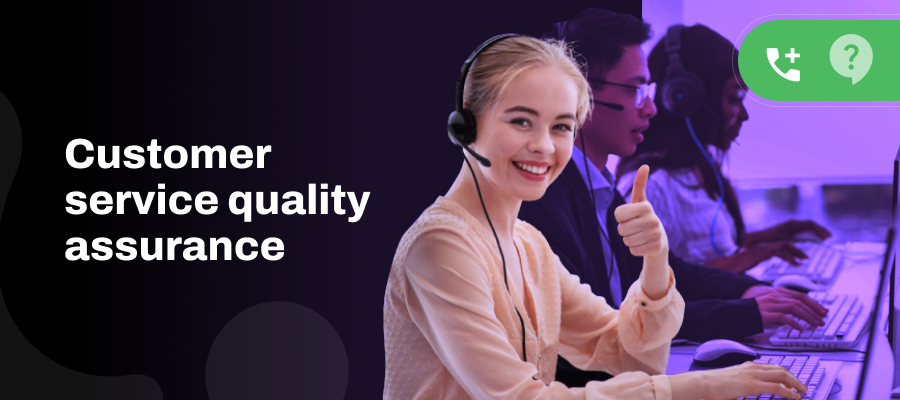How do you ensure your customer service team is delivering great support? Metrics like response time and resolution rate are not enough to understand how well customers are treated, and surveys don’t always tell the full story.
A strong customer support quality assurance process helps you evaluate interactions, identify issues, maintain high service standards and prevent declining service quality as you scale.
In this guide, you’ll learn the concept of customer support quality assurance, its benefits, how to create a QA program and measure its impact.
What is Customer Support Quality Assurance?
Customer support quality assurance (QA) is a structured process of assessing customer interactions to ensure that every customer interaction is handled with professionalism, care and efficiency.
Customer support QA helps you:
» Improve agent performance by providing helpful feedback
» Improve overall performance by optimizing the customer support flow based on collected data
» Monitor operations and identify problems by analyzing existing processes
» Continuous improvement by identifying issues and working on them
Benefits of Customer Support Quality Assurance
Customer support quality assurance helps businesses deliver consistent, high-quality support and improve over time. Here are some benefits of implementing the right QA process in your customer support:
1. Get Actionable Insights
QA managers can get key metrics like Net Promoter Scores (NPS) and customer satisfaction scores (CSAT) to understand how your team is performing. Based on these insights, they can address issues individually, such as reviewing challenging customer interactions and providing tips and guidance on improving.
2. Maintain Service Consistency
Businesses can standardize quality benchmark scores and prepare checklists to ensure all agents follow the same approach, leading to quality consistency across the board. QA managers can create training programs that align with the organization’s best practices and guide agents to perform better.
3. Enhance Employee Experience
An effective QA program can help you recognize good performers and celebrate positive customer interactions instead of only highlighting negative behaviors. Additionally, you can use QA to accelerate onboarding and provide ongoing coaching and ways for career growth, which can result in improved job satisfaction.
4. Retain More Customers
Offering a good quality service to customers means they’re more likely to return and make repeat purchases. QA can help you reduce response times, solve customer issues promptly and provide excellent service quality. This can boost customer retention and increase customer loyalty for your brand.
How to Create a Customer Service Quality Assurance Program?
Building a QA program requires a structured approach to setting standards, evaluating interactions, and making continuous improvements. Whether you are starting from scratch or refining an existing process, follow these steps to create an effective QA program.
1. Determine QA Objectives
First, define your objectives and customer support values, as service standards vary from one company to another. You can also collect customer feedback to understand how your team can perform better and set specific goals.
For example, if customers say they didn’t get timely support, one of your goals can be to improve response times.
2. Hire a Specialist or Set Up a QA Team
The QA managers may feel pressured as the volume of conversations increases. If you have a large business, the smartest way to go about it is to hire a QA specialist to grade support conversations. These specialists may only focus on evaluating customer service conversations and provide in-depth reviews and suggestions.
You can also consider setting up a quality assurance team of senior support managers and team leaders. The team can use their expertise and knowledge to analyze quality assurance reviews skillfully.
3. Prepare QA Scorecards
Scorecards or rubrics can help you standardize the QA process, by measuring the conversation quality against a specific criteria.
They can be either of these types:
» Questionnaire having yes / no answers (for e.g., “Did the agent follow the X process?”)
» Grading system that assign points to each question based on whether agents completed a specific task appropriately
4. Review Conversations Selectively
It may not be feasible to evaluate every conversation, but you can randomly pick calls or have a targeted strategy to select the interactions for review. This may include focusing on calls or emails handled by new agents or conversations rated poor.
5. Measure Customer Service Quality
Once the QA system is set up, regularly measure customer service quality to ensure good performance from agents. Monitor key metrics such as CSAT and customer survey results and review QA scorecards to understand how well you are performing.
Continuous reviews can help you quickly spot errors and fix them immediately before they escalate.
Best Practices for Customer Support Quality Assurance
Here are proven tips and best practices to help you optimize your quality assurance process and leave a lasting impression on every customer:
⇒ Clearly define KPIs: Establish clear and measurable metrics aligned with your QA goals, such as response time, average handle time, first call resolution, and customer satisfaction
⇒ Monitor calls in real-time: This enables immediate feedback and interventions during challenging situations. You can also schedule periodic call monitoring sessions to evaluate customer interactions and use call recordings and transcripts to analyze interactions deeply.
⇒ Reward good performances: Implement performance-based incentives to motivate agents to deliver high-quality service consistently. Awarding top performers will also encourage healthy competition among your customer service agents.
⇒ Create ongoing training for agents: Regular and ongoing training helps agents understand QA guidelines better, learn from past mistakes, and adapt to evolving customer expectations. This also allows agents to stay updated on new policies, tools, and communication techniques.
⇒ Monitor conversations across channels: Extend your customer service quality assurance to every channel you use, including live chat, email, and texts, to gain a holistic understanding of agent performance
⇒ Leverage AI for quicker insights: AI-powered tools can automatically analyze customer interactions and identify common issues and agent performance gaps in real-time. It can also assess sentiment and detect compliance issues.
Customer Service Quality Assurance Checklist
The call center quality can be measured from different perspectives, which may vary as per your business goals. Here are the most important aspects of customer service quality assurance program you can consider:
1. Soft Skills
» Grammar and spelling: Correct punctuation, spelling, and construction of sentences
» Tone: Slow, thoughtful responses, use of positive and encouraging language, thanking and welcoming the customer
» Empathy: Use of polite language that shows care and concern with phrases like, “I completely understand what you feel” or “That must be so frustrating. I am here to help.”
2. Issue Resolution
» Effectiveness: Identifying the customer’s issue correctly, improving first contact resolution, and minimizing customer effort
» Clarity: Using simple and straightforward language, without any jargon and complex sentences
» Product knowledge: Accuracy in product-related answers, in-depth understanding of key product features, troubleshooting, and staying updated with evolving product features
3. Support Procedure
» Productivity: Resolving concerns swiftly without sacrificing service quality, using sharp thinking and reliable information
» Compliance with processes: How well agents use internal support tools and resources like knowledge bases and canned responses. It also involves tagging tickets correctly and routing or forwarding calls to the right department
» Compliance with privacy policies: Agents should follow legal standards such as PII security, HIPAA mandates, and corporate guidelines
Ensure Superior Customer Service with Exotel
Exotel is an AI-powered contact center platform that helps businesses deliver exceptional customer service. It suits companies of all sizes and can scale with growing business demands.
Some of its top features include:
» Smart IVR to drive faster resolutions
» Reports and dashboards to monitor and evaluate agent performance
» Live monitoring to take proactive measures and resolve issues faster
» Integration with CRM and other tools to access information across various sources
» Auto-call distributor to prioritize high-value customers
Request a demo today to learn more about how Exotel can improve your customer interactions.
Frequently Asked Questions
1. How Do You Check QA in a Call Center?
Checking QA in a call center environment involves measuring employee performance against set standards, ensuring agents follow call scripts, adhere to company guidelines, and resolve issues effectively.
2. What is the Role of a QA Specialist in a Call Center?
A QA specialist evaluates agent interactions, identifies training needs, and suggests improvements to refine agent skills.
3. What is the QA Score in a Call Center?
The QA score reflects an agent’s performance based on quality standards. It is calculated by measuring script adherence, response accuracy, and problem resolution.
 +91-808 8919 888
+91-808 8919 888 +91-808 8919 888
+91-808 8919 888 +966 135 181 912
+966 135 181 912




